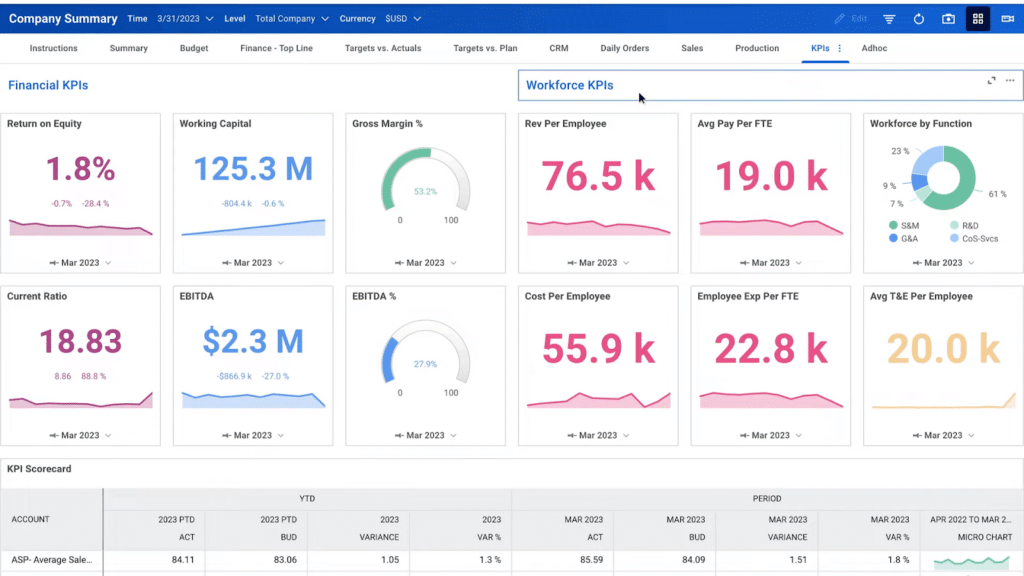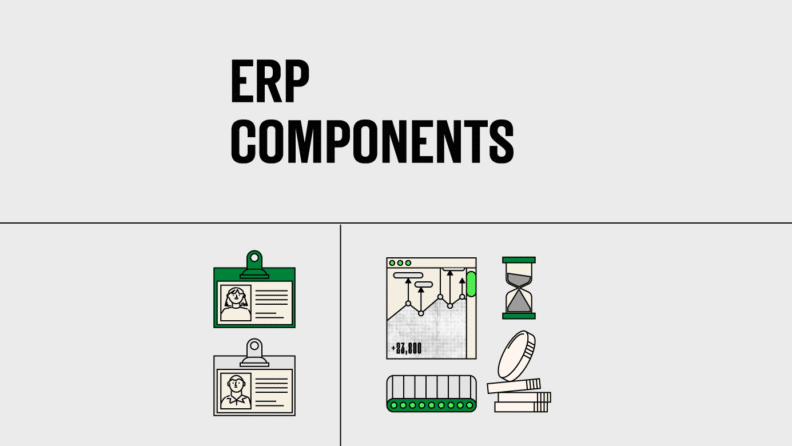ERP systems can be the key to running a better business… but only if you know how everything fits together. These are the 6 most common ERP components and how they work together to help you manage your organization.

What Are ERP System Components?
ERP system components are the different parts—known as modules—that make up Enterprise Resource Planning (ERP) software, each designed to manage a specific aspect of a business's operations, such as accounting or human resources.
You can think of each module as a digital employee, with its own job description. They function independently to manage their own area of the business, but ultimately work together to provide tools and features to streamline processes, gather data, and support decision-making.
6 Most Common ERP System Components
The following 6 components are sometimes referred to as the "core" components, as they’re the ones most commonly seen within all types of ERP systems.
1. Customer Relationship Management (CRM)
Every business's survival depends on managing prospects and existing customers. The CRM is a main component of the ERP system that collects and analyzes essential customer data, such as job details, geographical information, and contact behavioral details.
With the CRM component of an ERP system, your sales and marketing teams can access real-time customer data, providing a better understanding of customer behavior and sales trends.
Data from the CRM component of your ERP can be fed into other components—such as financial management and sales order management—allowing you to use one central hub to see all relevant information, like if they’re up-to-date on payments or ordering more of your products than usual.
2. Inventory Management
Inventory management in an ERP system helps businesses track all existing activities involved in producing and delivering finished products. Every production process has two things in common:
- It begins with obtaining raw materials from suppliers and ends with final delivery to clients or distribution partners, and
- When all activities within the supply chain are not managed adequately, order fulfillment cannot happen.
However, I’m simplifying things a bit here. Often, ERP systems have comprehensive modules for Supply Chain Management (SCM), Manufacturing and Logistics Management, and Inventory Management… but seeing as how most of my readers operate tech companies, we can roll this all into one.
The inventory management component helps businesses gather real-time data, match supply to customer demand, reduce operating costs, and respond quickly to changing business conditions. Because ERP systems store all business data in a single database, this provides you with a unified view of all product-based operations, alongside all relevant financial and procedural information.
Instead of relying on your employees to stay on top of supplies and purchasing, the inventory management component automates mundane activities like order processing by being set up to automatically order supplies when specific quantities are hit.
3. Accounting and Financial Management
The accounting and financial management component of an ERP system is believed to be the most crucial module—and I swear, I’m not just saying that because this is a finance-focused site.
This component ensures the accuracy and reliability of financial data, enabling informed decision-making and compliance with regulatory requirements. It consists of the tools companies use to monitor, record, and analyze different financial variables, such as:
- The general ledger
- Accounts payable (AP)
- Accounts receivable (AR)
- Budgets
- Forecasts
This component also tends to have advanced functionality, including tax management, fixed asset management, and multi-currency reconciliation, albeit perhaps a bit less commonly.

4. Business Intelligence (BI)
The BI component simplifies the process of collecting and analyzing data within the ERP system, ensuring you can make data-driven decisions within your business. Beyond its analytical capabilities, BI helps you make sense of data by simplifying it into numbers, tables, and visual reports.
By integrating data across departments, BI breaks down information silos, offering a holistic view of the organization and helping you make faster, smarter decisions for your business.
With AI functionality becoming commonplace, many systems will allow you to simply ask your ERP tool to forecast the most likely scenarios your business will encounter, based on historical data. While you’ll obviously want to take this information with a grain of salt, it can give you an unbiased opinion of what’s to come, given what has already happened.

5. Human Resource Management
The human resources management module of the ERP system helps to manage critical functions such as recruitment, onboarding, offboarding, timekeeping, and performance evaluation.
In some ERP software, this module can also double as payroll software by automating direct deposits for employees, based on your payroll information, which benefits you in more than one way:
- Reduction of clerical errors, like an extra zero on the end of a paycheck
- Time savings for you and your staff
HR modules also make the management of your workforce a lot more efficient. Just as an arcade game shows you the high scores of everyone who’s played it, your HR module can generate automatic employee performance reports, complete with visual aids like graphs and charts. This allows for early detection of performance issues and quicker intervention.
Finally, this component also tracks logged work hours, paid time off, and sick leave, ensuring accuracy and simplifying administrative tasks.
6. Project Management
The Project Management (PM) components in an ERP system are used to help project managers plan, execute, and monitor projects. Typical project management software provides tools for teams to allocate resources, track progress, and collaborate with other system-users without recurring meetings.
The PM component helps businesses efficiently manage projects, ensuring completion using allocated budgets and resources, while enhancing project visibility and successful project outcomes.

Most Common Secondary ERP System Components
Here are some ERP components that are still commonly used, but not offered across all systems:
Risk Management
The risk management component of ERP systems identifies risks to your business and may even suggest business continuity plans (BCPs) for emergencies.
It won't tell you that converting all your spare cash into crypto is a bad idea but hey, if it did, what would the CFO be for?
Warehouse Management
If you have a lot of products to keep track of, this is for you. Within an ERP system, the warehouse management module is designed to optimize product organization, storage, and movement within your warehouse(s).
This includes addressing key factors such as warehouse layout, material handling processes, and labor productivity.
If this is all you need the system for, you'd best look into a WMS instead.
Marketing Resource Management (MRM)
This ERP solution aligns people, processes, and tools to enhance marketing efforts and deliver targeted campaigns. If you’re investing in awareness, this is a great one to look into.
Sales Order Management
Sales order management streamlines the entire lifecycle of sales orders, from generation to billing and invoicing, decreasing the possibility of batons being dropped in the communication process.
Learn More About ERP Systems
If you’re just starting to learn about ERP systems, you should stick around. I’ve covered the software extensively, to teach you everything you’d need to know before you buy. This includes:
- 75% of Companies Fail – Here’s How to Use ERP Software Successfully
- What an ERP Consultant Does (& How to Best Use Them)
- SaaS ERP Vs Cloud ERP: Is There Any Real Difference?
Ready to compound your abilities as a finance leader? Subscribe to our free newsletter for expert advice, guides, and insights from finance leaders shaping the tech industry.



